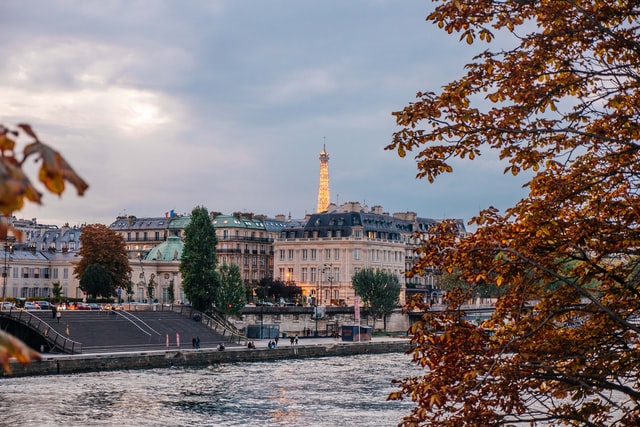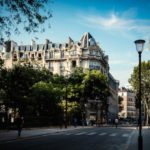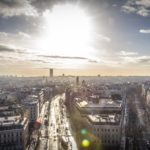Paris is Still Paris

“Paris is no longer Paris.”
The words stung as they rolled off the lips of my new president and out of my laptop speakers. Sure, it was no surprise to me that some people felt this way. My husband and I had heard similar sentiments from concerned family members before we left for our stint in Paris last September. But to hear it from the mouth of our president—direct from his friend and former Paris-lover, Jim—left me reeling with questions and rebuttals as I watched the speech unfold.
It was said so matter-of-factly, so condemningly, implying in not so many words that Paris, fallen from its former glory, was in shambles and no longer safe to visit. But I knew that wasn’t true. As I sat on the couch in my Paris apartment, I felt physically sick for the city I love and for all the people who would now be too afraid to travel.
Although a little battered and bruised, Paris is not defined by these struggles. The croissants are still just as buttery and, at twilight, the Eiffel Tower still sparkles over the Seine.
Since this speech, I’ve thought a lot about President Trump’s claim. It’s been recycled many times over as scared, would-be vacationers deliberate on travel forums whether or not they should cancel their plans. I don’t pretend to have been able to sort through all of the nuances surrounding what’s been said. But, I do feel that there are a few things that need to be addressed, especially by someone like myself who has been in the thick of it for the past few months.
First, it’s true that Paris does bear the weight of recent terror attacks, and the even more recent influx of migrants. Security measures throughout the city have been heightened since the brutal attack on a Paris concert hall in November 2015, and armed soldiers patrol the streets. Desperate, asylum-seeking migrants, especially from Afghanistan and Syria, camp in the Paris suburbs while local governments struggle to accommodate them. I won’t argue against these obvious changes to the Paris landscape in defense of this city. To do so would be ignorant and dishonest, not to mention insulting to those who have lost their lives to terrorist acts and who wait for asylum in these almost inhumane conditions.
All of that said, I have witnessed that although a little battered and bruised, Paris is not defined by these struggles. The croissants are still just as buttery and, at twilight, the Eiffel Tower still sparkles over the Seine. Café terraces are still the perfect place for people-watching and, during the spring and summer, the parks are still dotted with picnickers. Paris does not lay in ruin; it continues to thrive.
No, the sentiment that “Paris is no longer Paris” does not originate here. It goes much deeper than these horrible events, rooted in misguided assumptions about this city, arguably the most romanticized in the world—assumptions surrounding its cultural identity, its diversity, and its freedom to change.
Paris was an immovable, timeless symbol—otherworldly, yet boxed in—representing everything I craved most: rich European culture, intellectual enlightenment, and whimsical, breathless romance.
I must admit that I am guilty too. A self-proclaimed Francophile, I caught the Paris bug at an early age. I attribute this to watching Madeline one too many times… or was it The Aristocats? Later, I devoured my first Hemingway novel and tasted the language for the first time. I dreamed I too would someday find myself lounging at a Haussmann-style café overlooking the Seine, brooding as I sipped my espresso and scribbled down what would become the next great American novel.
The Paris in my mind’s eye, the Paris that I viewed through the lens of artists and storytellers of a bygone era, wasn’t just a city. It was an immovable, timeless symbol—otherworldly, yet boxed in—representing everything I craved most: rich European culture, intellectual enlightenment, and whimsical, breathless romance. I was nostalgic for a time and place I had never been.
I know I’m not alone in these feelings. And, quite frankly, it’s not all bad! Our infatuation with this image of the City of Light was born out of a lush, decades-long cultural exchange between France and the United States, an exchange that went both ways. But, what I have come to realize after living in this city is that it is in fact a city. A real city with real issues and real victories. A city that, along with its suburbs, is made up of nearly 11 million people—many of whom come from immigrant communities. A city that is dynamic, diverse, and ever-changing.
We must give Paris this freedom to evolve and even struggle as it always has. And, we must be willing to entertain the idea that the Paris of yesterday, creatively rendered by art, film, literature, and now the hopeful imaginings of policy-pushing politicians, may never have looked as we thought it did.
If Paris isn’t Paris anymore, I will take whatever it has become because despite that twinge of fear that creeps in when I get packed into a crowd, or that sadness that brings me to tears when I pass a Syrian family begging in the Metro, I am met with so much beauty when I head out into the world each day. I’ve discovered that beauty in places that my Madeline-watching self never would have expected. As my own assumptions and stereotypes melt away, I’ve found the real, raw, evolving Paris to be even more sweet.
Photo by Unsplash.com.









One thought on “Paris is Still Paris”